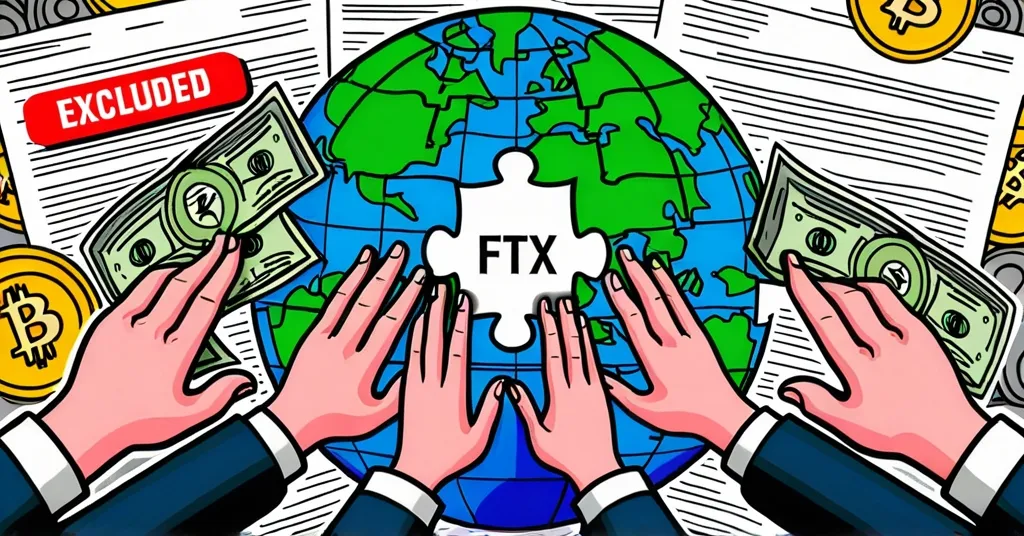FTX Begins $16B Creditor Repayment, Excludes Russia, China, and More

FTX Initiates $16 Billion Creditor Repayment, Excludes Key Regions
– FTX begins $16 billion creditor repayment.
– Russia, China, Ukraine, Nigeria, Egypt excluded.
– “Convenience Classes” prioritized for early payouts.
In a major move toward recovery, the bankrupt cryptocurrency exchange FTX has started the process of repaying its creditors, with an anticipated distribution of over $16 billion. Yet, this endeavor isn’t without its hurdles, as creditors in Russia, China, Ukraine, Nigeria, and Egypt are currently sidelined due to legal and logistical challenges. This follows the dramatic collapse of FTX in November 2022 and the subsequent sentencing of its founder, Sam Bankman-Fried, to 25 years in prison for fraud.
FTX is tackling the repayment process by prioritizing “Convenience Classes” – creditors with claims under $50,000 – who are set to receive their payments within 1-3 business days following the initial distribution announcement on February 18, 2025. Those missing this first round will have to wait until May 30, 2025, with the next record date for Convenience Claims scheduled for April 11, 2025. This phased approach aims to streamline the repayment process but leaves a significant portion of the global creditor base in a holding pattern.
Excluded Countries and the Challenges They Face
China, accounting for the largest share of affected customers at 8%, sees some of its users reporting claims under review or contested. The FTX estate is actively exploring solutions, yet the complexities of international bankruptcy law and the logistics of distribution continue to pose formidable challenges. Creditors in these excluded countries are understandably frustrated as they watch their counterparts elsewhere begin to recover their losses.
The exclusion of these regions stems from a tangle of legal and logistical issues. International bankruptcy law, which dictates the distribution of assets across borders, often creates significant hurdles. Sanctions against Russia and regulatory uncertainties in China further complicate the situation, leaving creditors in these areas waiting for resolution.
Legal Implications and the Shadow of Sam Bankman-Fried
The collapse of FTX served as a stark reminder of the inherent risks in the cryptocurrency space, with mismanagement and misuse of customer funds at its core. The ongoing repayments, facilitated through partners like BitGo and Kraken, mark a step toward recovery. However, the exclusion of certain countries underscores deeper systemic issues within the industry. As FTX navigates these turbulent waters, the crypto community remains both hopeful and cautious about the future.
Sam Bankman-Fried’s conviction and subsequent lengthy sentence highlight the gravity of the fraud. His legal team, however, is appealing the conviction, arguing that the trial was tainted by errors and false narratives. This adds yet another layer of uncertainty to the FTX saga, potentially impacting future trust in the crypto ecosystem.
Market Impact and the Road Ahead
As Bitcoin edges closer to the $100,000 mark, the repayments inject a glimmer of optimism into the market. Yet, the potential for increased selling pressure if creditors receive payouts in cryptocurrency remains a concern. The broader implications of FTX’s collapse and the regulatory gaps it exposed continue to fuel discussions about the need for stricter oversight in the industry.
While the repayments are a vital step in reclaiming lost funds, rebuilding trust in FTX and the wider crypto world will require more than just financial settlements. Investors are demanding greater transparency and robust risk management from exchanges, signaling a long road ahead for the industry’s recovery.
On a positive note, the turmoil surrounding FTX could spur innovation and push for more robust systems within the crypto space, aligning with the philosophy of effective accelerationism. Bitcoin’s decentralized nature, in contrast to centralized exchanges like FTX, underscores the importance of decentralization in building a more trustworthy financial system.
Key Questions and Takeaways
- What is the total amount FTX expects to distribute to creditors?
Over $16 billion.
- Which countries are currently unable to participate in FTX’s creditor distributions?
- What percentage of affected customers does China account for?
8%.
- What is the “Convenience Classes” group in the context of FTX’s repayment plan?
It refers to creditors with claims under $50,000, who are prioritized for initial distributions.
- When was the first round of distributions announced?
February 18, 2025.
- What happens to customers who miss the initial distribution?
They will have to wait until May 30, 2025, for the next distribution.
- When is the next record date for Convenience Claims?
April 11, 2025.
- What was the outcome of Sam Bankman-Fried’s legal proceedings?
He was found guilty and sentenced to 25 years in prison for fraud.
- How might the FTX collapse influence the broader crypto market?
It could spur innovation and push for more robust systems, aligning with the philosophy of effective accelerationism.
- What does the exclusion of certain countries highlight about the crypto industry?
It underscores the need for clearer international regulations and better logistical planning in cross-border asset distributions.
“The next record date for Convenience Claims that have become allowed since the initial record date and have not received their distribution is set for April 11, 2025. The Next Distribution is expected to commence on May 30, 2025,” – FTX Official X post.



